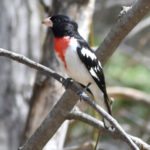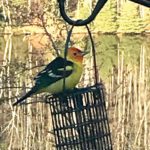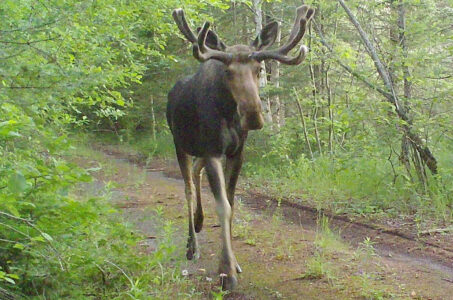Grosbeaks, hummingbirds arrive
Northwoods Notebook
- (Betsy Bloom/ Daily News photo0The rose-breasted grosbeak, which migrates to Mexico and central America in winter, is one of the one of the prettiest and best-traveled songbirds in North America.
- A western tanager found its way to a feeder in the Kingsford area this spring.
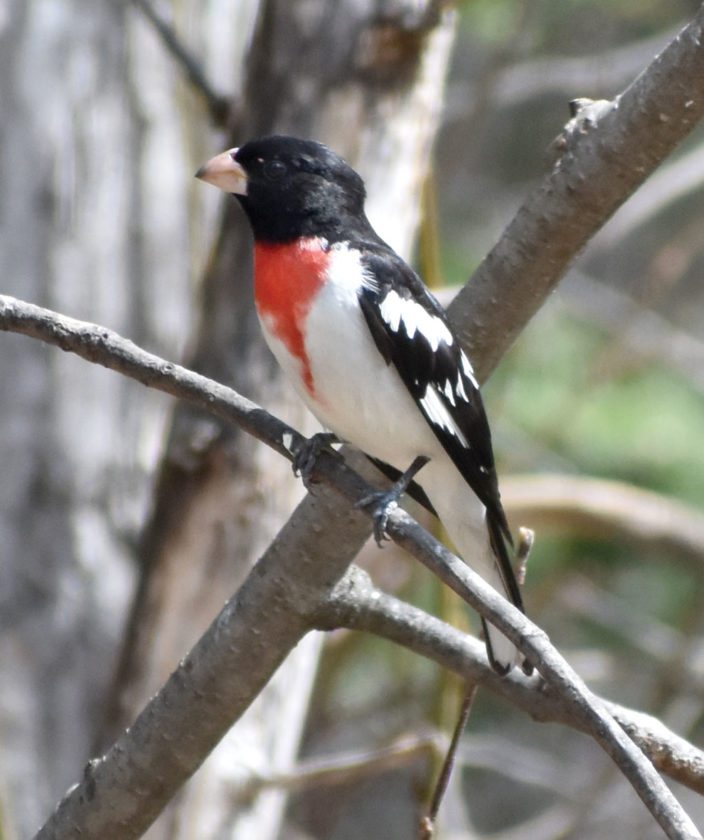
(Betsy Bloom/ Daily News photo0The rose-breasted grosbeak, which migrates to Mexico and central America in winter, is one of the one of the prettiest and best-traveled songbirds in North America.
Another week, another wave of migrating birds through the region.
This was one that many area residents await with great anticipation in spring — the return of Baltimore orioles, rose-breasted grosbeaks and ruby-throated hummingbirds to the area. If you don’t have the feeders up already, it’s time to get those orange halves out there and cook up a batch of nectar for the smallest of our avian species.
I say cook, because making your own nectar is cheaper than buying it and doesn’t have the addition of red dyes that most commercial products seem compelled to include as a supposed attractant to hummingbirds.
Some manufacturers contend there’s no real evidence the dye has any adverse effect on the hummingbirds. For awhile, we used a bottled variety that had color taken from a type of beetle, because it also touted being boosted with minerals, especially calcium for building eggshells.
I’m not going to wade into the debate here. I’m just going to point out the traffic at the feeder didn’t slow down when we switched to homemade, colorless nectar. That can be made in smaller batches, too, to better avoid the risk of it going bad before being used.
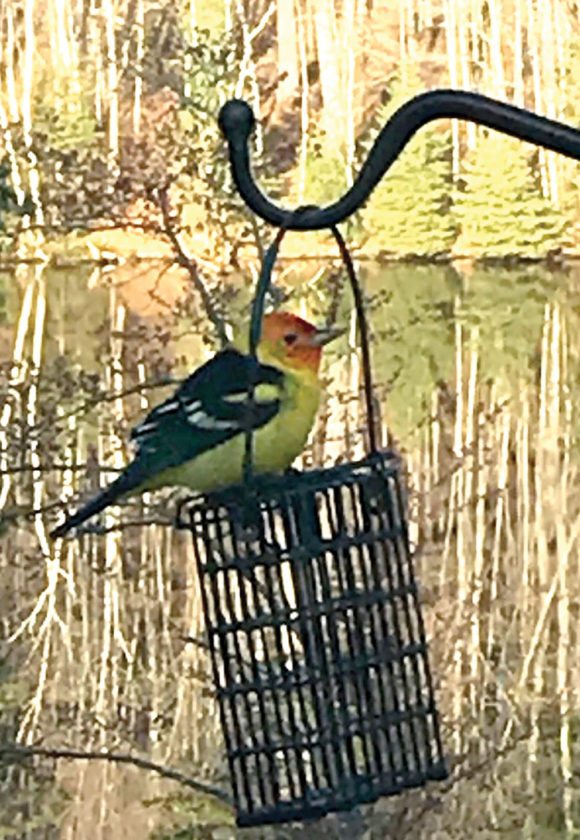
A western tanager found its way to a feeder in the Kingsford area this spring.
We use a very basic formula — a cup of sugar added to 4 cups of water, then brought to a boil — but readers are invited to share if they have a better recipe. We also don’t make a separate sugar water concoction for the orioles; they seem to prefer the oranges and grape jelly, anyway, and I’ve seen them just tap the hummingbird feeder when seeking nectar.
Away from the backyards, common loons are back at most area lakes, and some of the waterfowl, such as Canada geese and mallard ducks, already may be nesting. Same with sandhill cranes.
So what’s left to watch for in the region? A major pulse out of Illinois indicates the migration continues, so a fair number of warblers, vireos and thrushes probably still are making their way here. The nighthawks have yet to arrive as well.
But perhaps the major one to still watch for at feeders would be indigo buntings, which have shown up in good numbers in Wisconsin but in checking the lists have not yet been reported in the U.P. this spring. At our place, indigo buntings can be hit-and-miss from year to year, so it could be possible it’s back, just not in my backyard.
Though these deep blue birds look like a type of finch, they actually are classified in the same family as cardinals and tanagers — as are the rose-breasted grosbeaks, which despite sharing a name are not considered close kin to the other native grosbeaks in the U.P., the evening and pine.
*****
Staying with the same family, scarlet tanagers likely have returned to the North Woods as well but often can be difficult to spot despite being so boldly colored, with vivid red bodies and black wings and tails. The green-yellow females can be even harder to discern among the treetops. But occasionally they will decide to try a feeder, providing a rare open view of a bird that seems more decked out for the tropics. Indeed, this species spends the winters in northern an western South America, according to the Cornell Lab of Ornithology.
The all-red summer tanagers, more common in the southern and southeastern U.S., also will regularly stray into the U.P., with one photographed in Houghton County earlier this month, though it was a yellow female. Several have appeared in Wisconsin.
But the tanager that showed up at a feeder in the Kingsford area — well, that one was well off course.
“I had not ever seen one before,” said the woman who looked out her kitchen window to see, perched on a suet cage, a bright yellow and black bird with a face of flaming red-orange.
Though not a regular “birder,” she knew enough to get a photo with her cell phone — not the best shot but clear enough for a friend to identify it as a male western tanager.
As the name implies, the western tanager tends to stick to the western United States and Canada during the summer. Even when migrating, it usually doesn’t range beyond western Nebraska and the Dakotas.
And when it does stray, it’s usually during fall migration, when the males will take on more subdued plumage. This one was in full breeding glory.
It only stayed for a day, she said. Still, the woman asked her name not be used — she fears an influx of birders looking for what would be a rarity here.
But she was willing to share her photo, so I have done the same.
*****
Other spring notes: The reptiles — turtles and snakes — are active again, the ticks sound like they are thick out there in what could be a nasty summer for the parasite and the deer are dispersing, though the does for now appear to still tolerate the yearling fawns.
Betsy Bloom can be reached at 906-774-2772, ext. 40, or bbloom@ironmountaindailynews.com.

